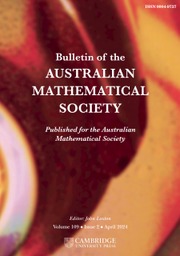No CrossRef data available.
Article contents
A NOTE ON THE GENERALISED RAMANUJAN–NAGELL EQUATION  $x^2=2^m+p^n$
$x^2=2^m+p^n$
Published online by Cambridge University Press: 12 September 2025
Abstract
Let p be a fixed odd prime. We prove the following results for positive integer solutions  $(x,m,n)$ of the equation
$(x,m,n)$ of the equation  $(*)\ x^2=2^m+p^n$. (i) If
$(*)\ x^2=2^m+p^n$. (i) If  $p \equiv 3 \pmod 8$, then
$p \equiv 3 \pmod 8$, then  $(*)$ has only the solution
$(*)$ has only the solution  $(p,x,m,n)=(3,5,4,2)$. (ii) If
$(p,x,m,n)=(3,5,4,2)$. (ii) If  $p \equiv 5 \pmod 8$, then
$p \equiv 5 \pmod 8$, then  $(*)$ has only the solution
$(*)$ has only the solution  $(p,x,m,n)=(5,3,2,1)$. (iii) If
$(p,x,m,n)=(5,3,2,1)$. (iii) If  $p \equiv 7 \pmod 8$, then
$p \equiv 7 \pmod 8$, then  $(*)$ has at most one solution
$(*)$ has at most one solution  $(x,m,n)$, except for
$(x,m,n)$, except for  $p=7$,
$p=7$,  $(x,m,n)=(3,1,1)$ and
$(x,m,n)=(3,1,1)$ and  $(9,5,2)$. Moreover, if
$(9,5,2)$. Moreover, if  $p=2^q-1$ is a Mersenne prime with
$p=2^q-1$ is a Mersenne prime with  $p>7$, where q is an odd prime with
$p>7$, where q is an odd prime with  $q>3$, then
$q>3$, then  $(*)$ has exactly one solution
$(*)$ has exactly one solution  $(x,m,n)=(2^q+1,q+2,2)$. If
$(x,m,n)=(2^q+1,q+2,2)$. If  $p \equiv 7\pmod 8$, p is not a Mersenne prime and either
$p \equiv 7\pmod 8$, p is not a Mersenne prime and either  $p<1.5\times 10^{12}$ or
$p<1.5\times 10^{12}$ or  $p>C$, where C is an effectively computable absolute constant, then
$p>C$, where C is an effectively computable absolute constant, then  $(*)$ has only the solutions
$(*)$ has only the solutions  $p=a^2-2$, where a is an odd positive integer,
$p=a^2-2$, where a is an odd positive integer,  $(x,m,n)=(a,1,1)$. (iv) If
$(x,m,n)=(a,1,1)$. (iv) If  $p \equiv 1\pmod 8$ with
$p \equiv 1\pmod 8$ with  $p \ne 17$, then
$p \ne 17$, then  $(*)$ has at most two solutions
$(*)$ has at most two solutions  $(x,m,n)$.
$(x,m,n)$.
Keywords
MSC classification
Information
- Type
- Research Article
- Information
- Copyright
- © The Author(s), 2025. Published by Cambridge University Press on behalf of Australian Mathematical Publishing Association Inc
Footnotes
The first author is supported by JSPS KAKENHI Grant Number JP24K06654.


